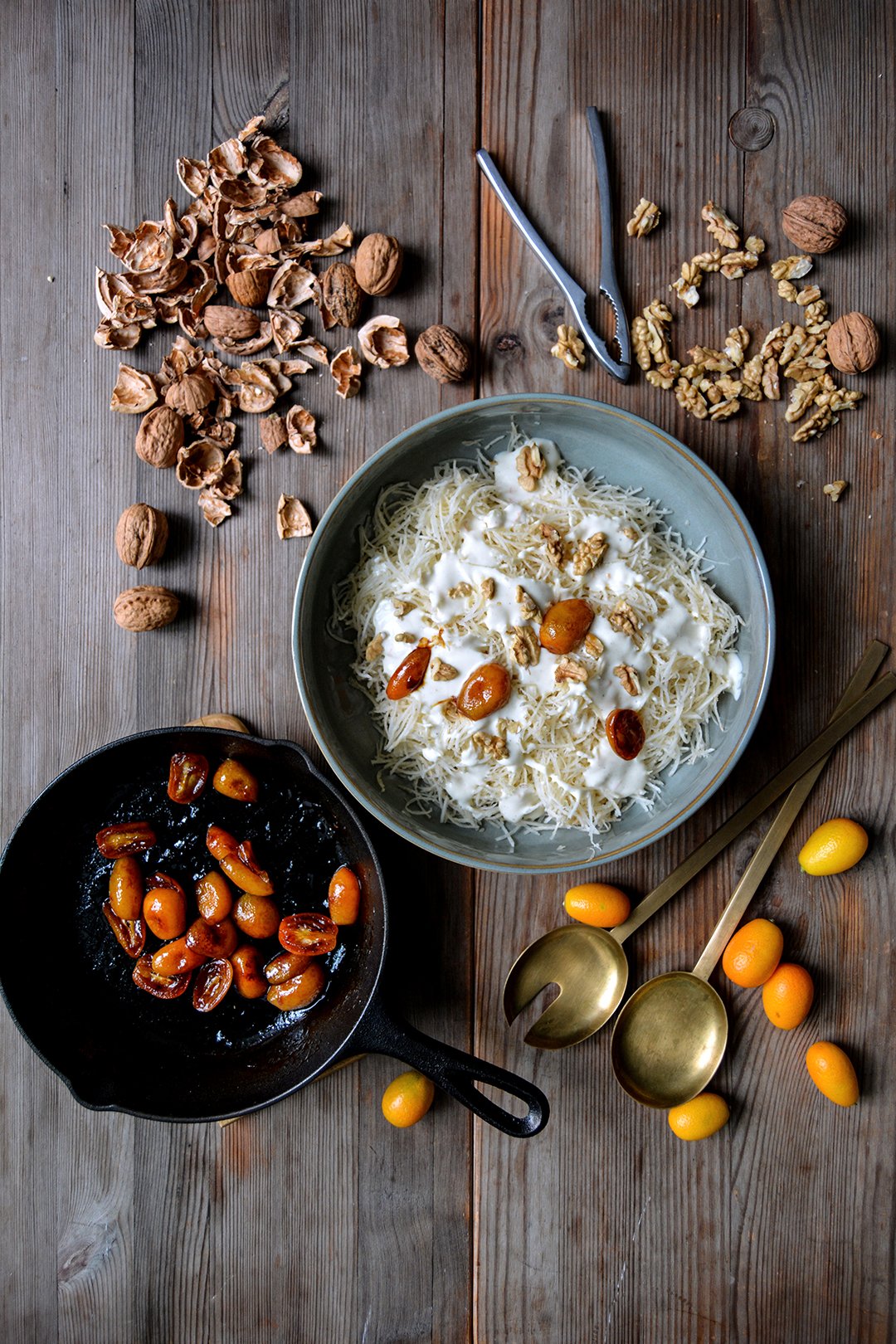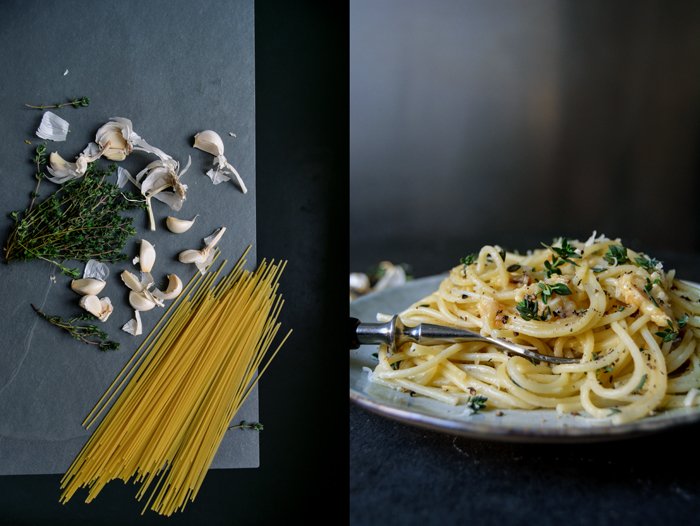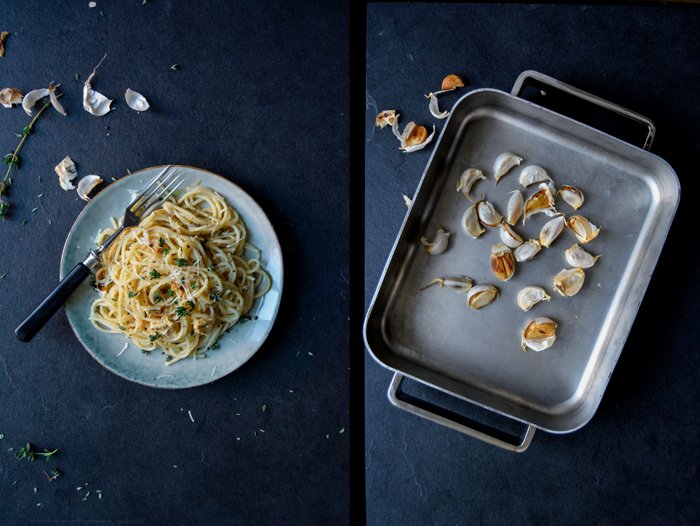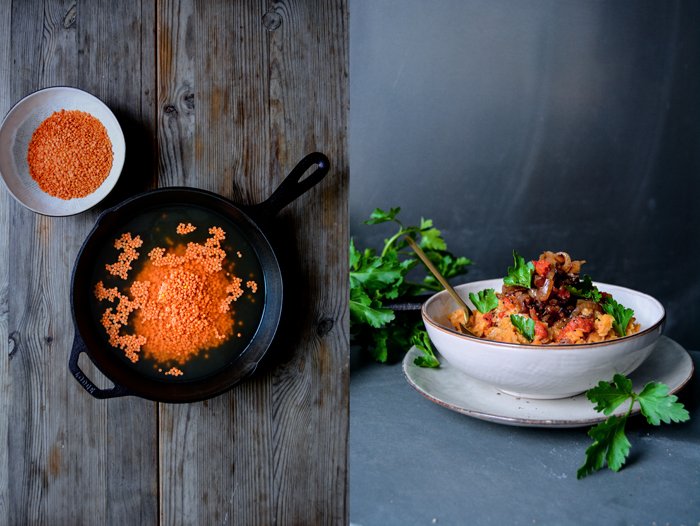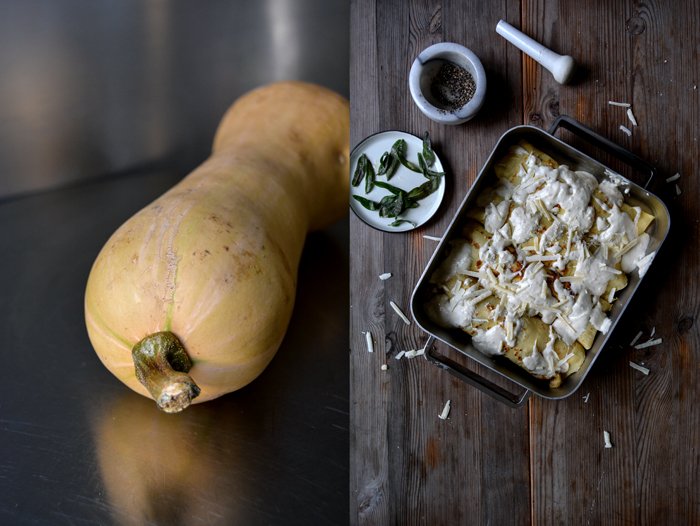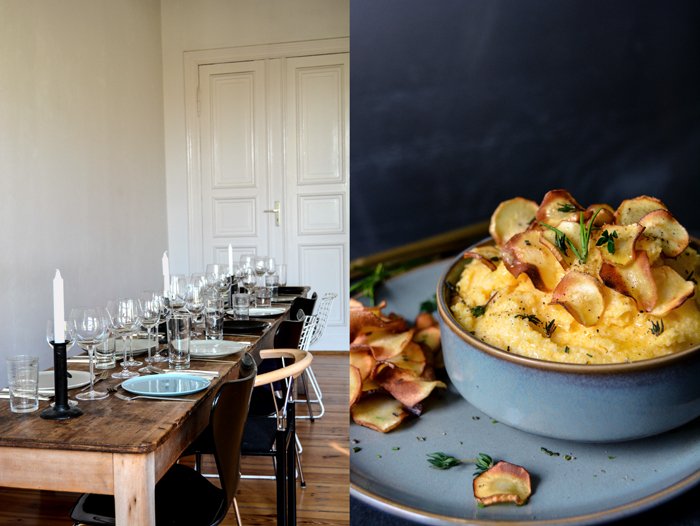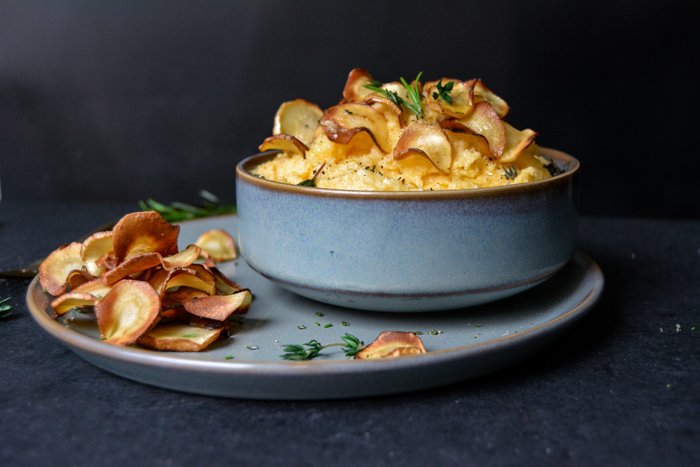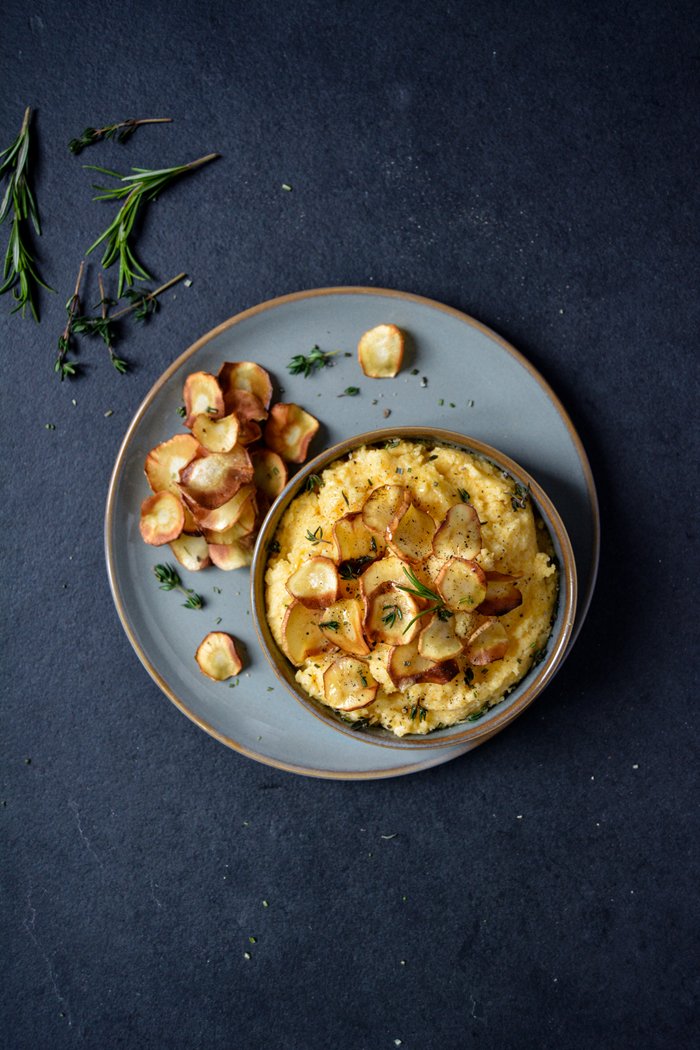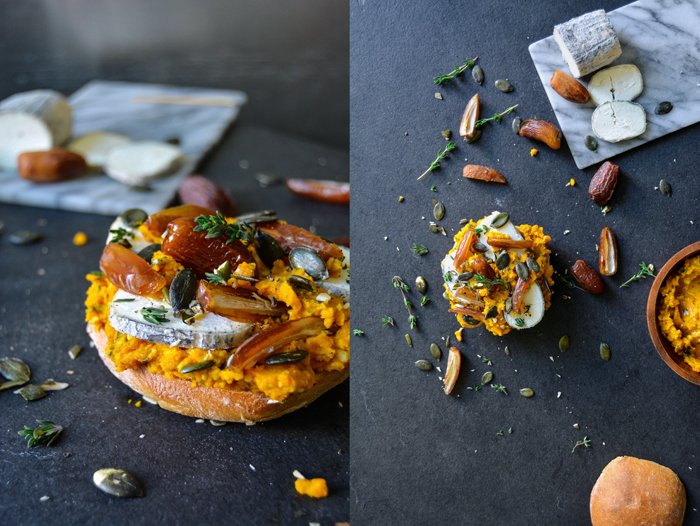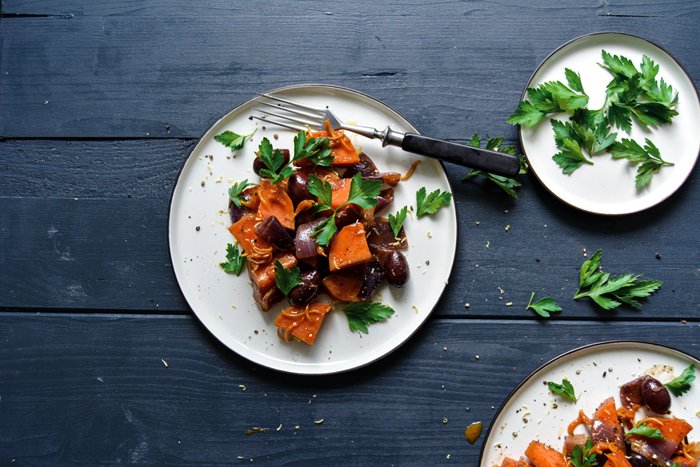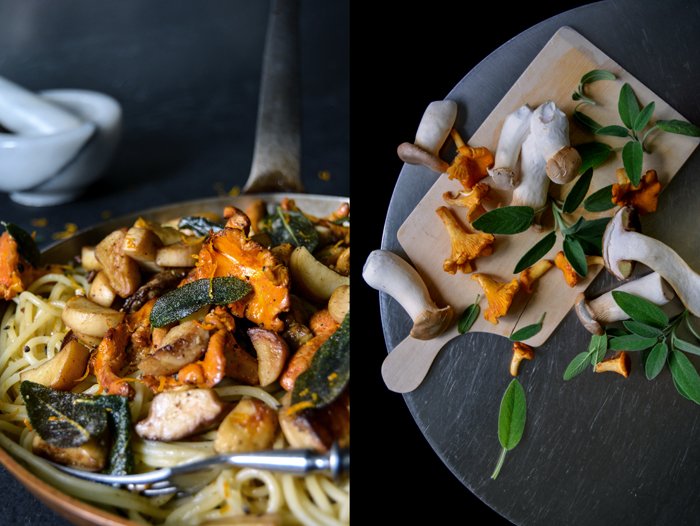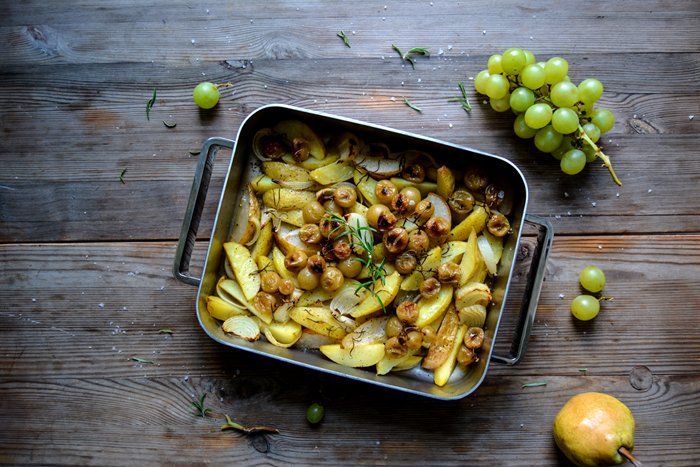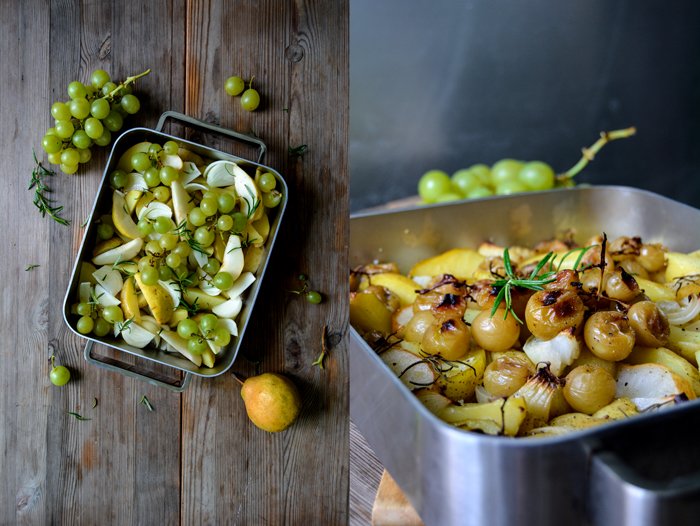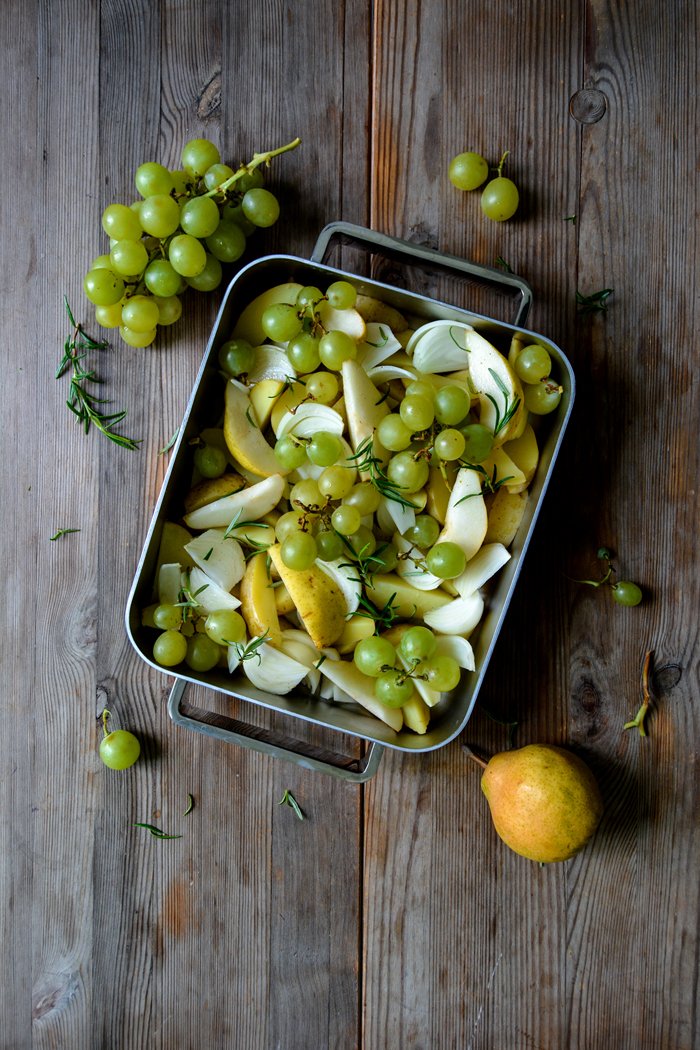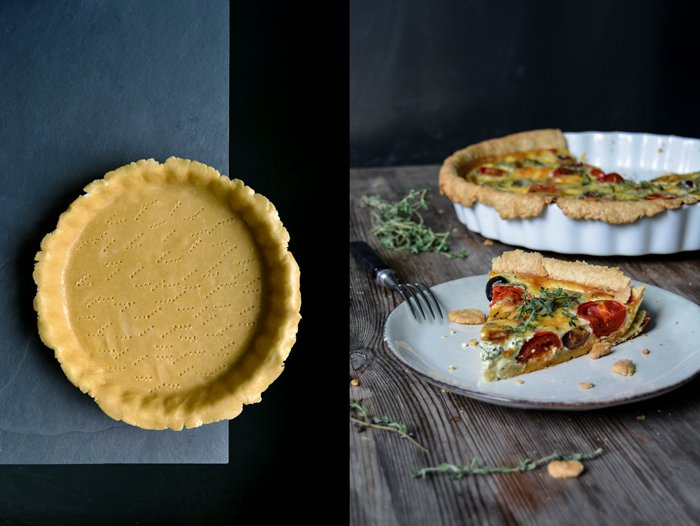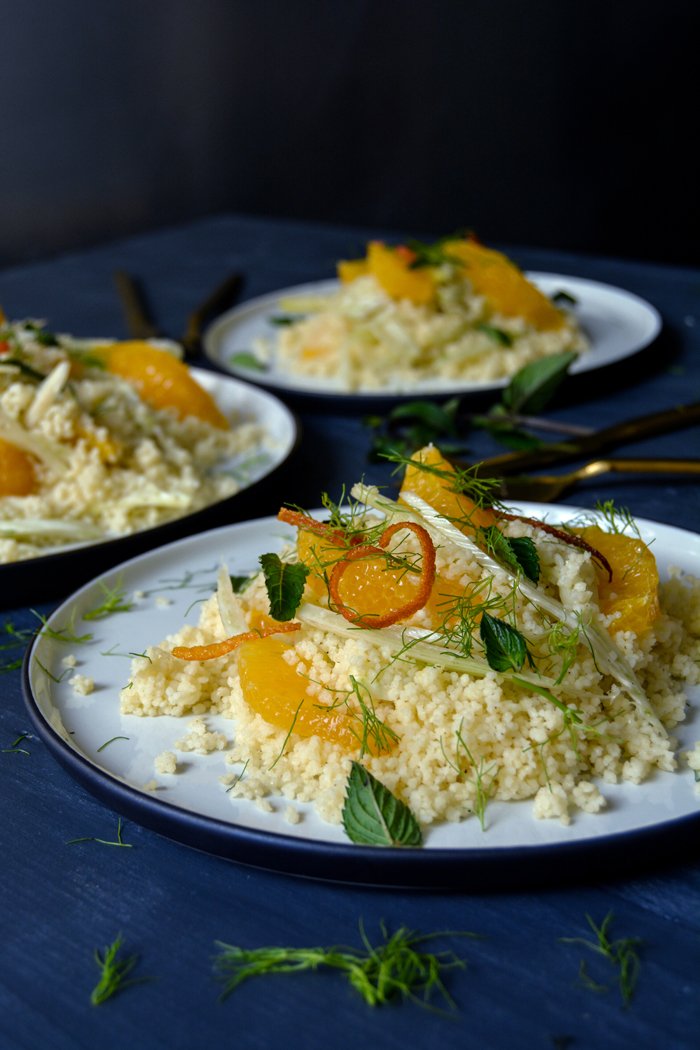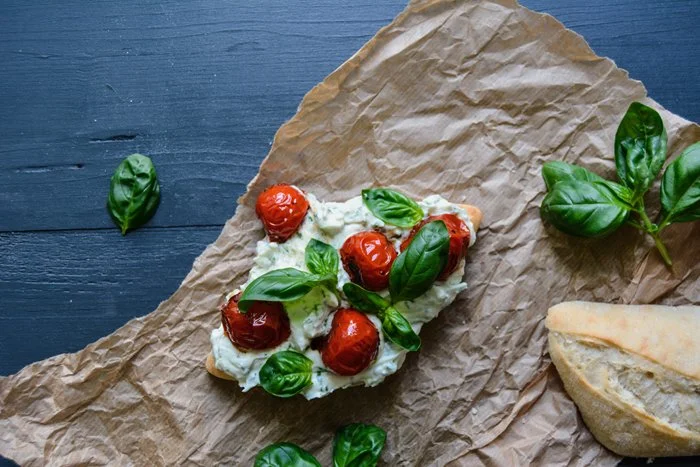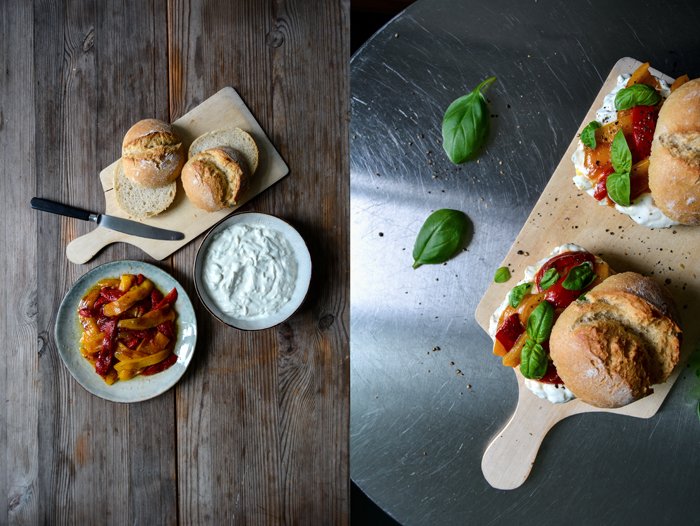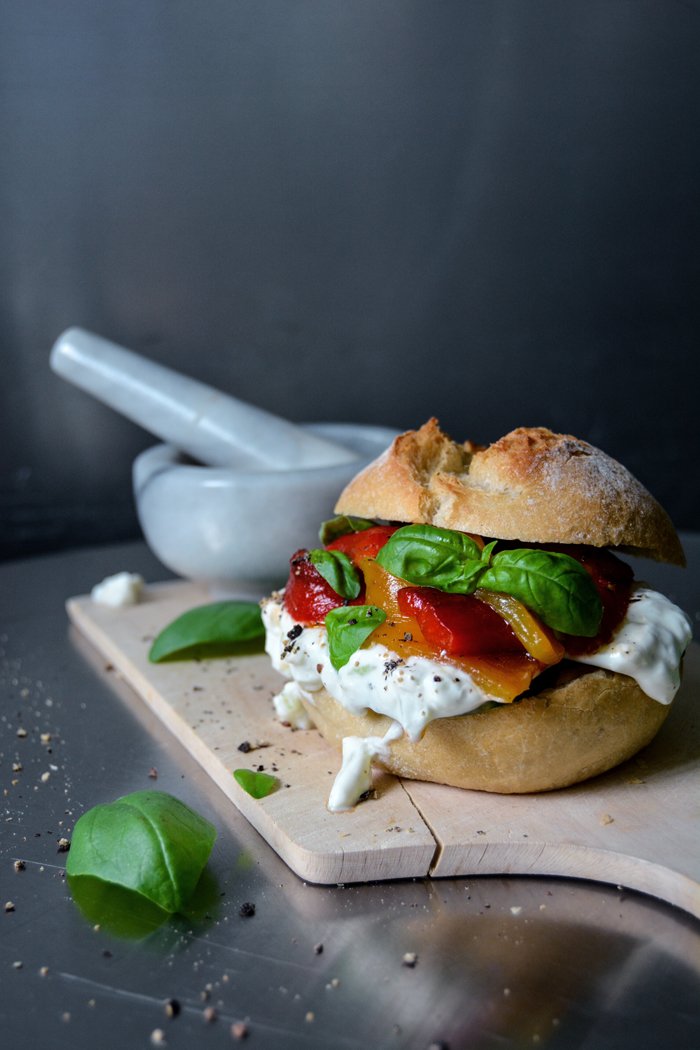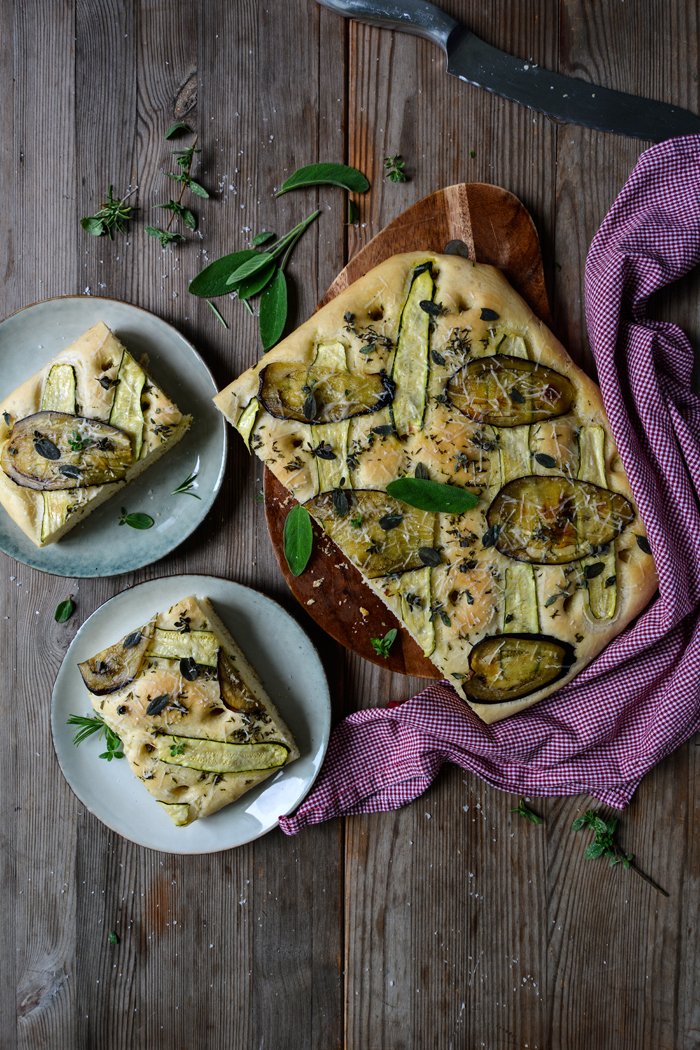Celeriac Salad with Caramelized Honey Kumquats and Walnuts
Berlin, January 2016:
My little cookbook library got extended by a few amazing recipe collections. Santa was so kind to leave a few gems under the tree: Nigel Slater's new The Kitchen Diaries III, Jerusalem by Yotam Ottolenghi and Sami Tamimi (finally!), Vegetarian India by Madhur Jaffrey, and the fantastic Anatolia by Somer Sivrioglu and David Dale. The latter blew me away! This book is gorgeous, the pictures are mouthwatering and the dishes inspired me as soon as I laid my eyes on the first page. I'll definitely write about it again in the next few weeks, I already tried one of the recipes for a Turkish pizza and it was divine.
Madhur is a new find for me, I haven't had much time to thumb through the pages of her book but what I've seen so far looks divine. Nigel's book is a cooking bible with 250 (!) recipes - and I'm already struggling with the amount of work I have with the 100 recipes in my Eat in My Kitchen book! I love his approach to creating recipes, the way he writes about them and the beautiful photos taken by Jonathan Lovekin who's also been responsible for Nigel's former kitchen diaries, which I'm equally obsessed with. I'm sure I'll spend quite some time with this book in the next few years.
One of Nigel's creations, which is the 248th recipe in the book, struck me right away: a gorgeous celeriac and blood orange salad sprinkled with nigella seeds and capers. I haven't tried it yet - but I will soon - however, it made me think about celeriac salads. I like the addition of citrus, especially my beloved blood orange, but so far they haven't been in sight at the market. Kumquats came to mind, caramelized and softened in sizzling honey, I used these sweet, sour, and bitter bites for my luscious Orange Blossom, Ricotta, Kumquat, and Pistachio Tartine last April. It was quite a beauty. For my salad of grated celeriac, I also added a creamy yet light yoghurt-cardamom dressing, and sprinkled it with walnuts. Some honey drizzled on top to enhance the sweetness and my first winter salad of 2016 was born. Thank you Nigel!
If you're not that fond of kumquats, you can replace them with orange fillets.
Celeriac Salad with Cardamom-Yoghurt, Caramelized Honey Kumquats, and Walnuts
Serves 3-4
For the dressing
yoghurt 200g / 2/3 cup
olive oil 2 tablespoons
freshly squeezed orange juice 1 tablespoon
ground cardamom 1/4 teaspoon
freshly grated orange zest 1/2 teaspoon plus 1 teaspoon for the topping
fine sea salt
ground pepper
For the salad
peeled celeriac, grated, 250g / 9 ounces
freshly squeezed lemon juice 1 tablespoon
liquid honey 1 tablespoon plus 1-2 tablespoons for the topping
freshly squeezed orange juice 4 tablespoons
kumquats, cut in half lengthwise, 12 (or 12 orange fillets)
walnuts, 1 large handful
a few black peppercorns, crushed in a mortar
For the dressing, whisk together all the ingredients until smooth and season to taste with salt, pepper, cardamom and orange juice.
In a large bowl, mix the grated celeriac and lemon juice, using your fingers. Sprinkle with the dressing.
Heat 1 tablespoon of the honey in a small, heavy pan on high heat, add the kumquats and the orange juice and cook for about 2-4 minutes or until soft and caramelized, turn them once or twice and mind that they don't burn. Take the pan off the heat and arrange the kumquats on top of the salad.
Sprinkle the salad with walnuts, crushed pepper, and additional orange zest, and drizzle with honey. Enjoy immediately or let it sit for a few hours. It won't look as pretty anymore but tastes just as good.
Chickpea Potato Soup with Rucola Pesto, Lemon and Fried Chickpeas
A couple days ago, we left Berlin to visit the gardens of Sanssouci Palace a few miles outside Berlin. The palace used to be the Prussian king, Frederick the Great's summer residence, built in the 18th century. The building itself is beautiful but the terraced garden is stunning. I love being there in summer, when it's all lush, green and in bloom but there's a certain melancholic mood woven into the misty air on a cold, grey day that fits this time of the year perfectly. It's pure silence, no leaves left on the trees, the marble sculptures high up on their pedestals looking down on us, wrapped in jackets and scarves on our way to another one of the park's winter attractions, a Christmas market and its warming mulled wine.
When we got home I felt so frozen that I promised myself I'd make a rich soup the next day. I cooked canned chickpeas and potatoes in broth, puréed it into a velvety, smooth soup and sprinkled it with fresh rucola pesto, lemon zest and fried chickpeas. It's a great winter soup, thick and refreshing, and just right before tomorrow's feasting begins.
I wish you a wonderful and peaceful Christmas with your loved ones. Enjoy the moments of love, joy and good food! xx
Chickpea Potato Soup with Rucola Pesto, Lemon and Fried Chickpeas
You won't need all the pesto for the soup but I don't like making pesto in small batches. We used the remaining pesto to spread on toasted dark bread, which we enjoyed with the soup.
Serves 2-4
For the soup
olive oil
medium onion, chopped, 1
garlic, crushed, 2 large cloves
potatoes, peeled, cut into cubes, 250g / 9 ounces
canned chickpeas, rinsed and drained, 250g / 9 ounces, reserve 4 tablespoons for the topping
vegetable broth 900ml / 3 3/4 cups
bay leaf 1
salt
ground pepper
nutmeg, preferably freshly grated
ground cumin 1/8 teaspoon
For the pesto
rucola (arugula) leaves 60g / 2 ounces
Parmesan 25g / 1 ounce
pine nuts 25g / 1 ounce
olive oil 75 ml / 1/3 cup
salt 1/8 teaspoon
For the topping
freshly squeezed lemon juice
olive oil
lemon zest
black peppercorns, crushed in a mortar
For the soup, heat a splash of olive oil in a large pot and sauté the onion on medium-heat for a few minutes until golden and soft. Add the garlic and cook for 1 minute. Add the potatoes and chickpeas, stir and cook for 1 minute. Pour in the broth, add the bay leaf, and season with a little salt and pepper. Lower the heat and simmer, uncovered, for 20-25 minutes or until the potatoes are soft.
While the soup is cooking, purée the ingredients for the rucola pesto in a blender or food processor. Season to taste and set aside.
For the fried chickpeas, heat a splash of olive oil in a small, heavy pan on high heat. Add the reserved chickpeas, close with a lid immediately (the chickpeas will pop) and fry for 1 minute or until golden. Take the pan off the heat.
When the potatoes are soft, discard the bay leaf and purée the soup in a blender, food processor or with an immersion blender until smooth. Season with salt, pepper, nutmeg and cumin to taste, bring to the boil, and simmer for 1 minute, stirring constantly. Divide the soup between bowls, drizzle with a little lemon juice and olive oil and sprinkle with rucola pesto, lemon zest, crushed pepper and the fried chickpeas.
Roasted Garlic Butter Spaghetti with Thyme
The amount of garlic in this velvety, buttery pasta recipe sounds intimidating but if you let go of the idea of harsh, raw garlic and think of smooth, almost perfumed, oven-roasted cloves instead, it makes a lot of sense.
I used 22 large cloves, cooked in their skins in a hot oven. This kind of roasting turns them into a sweet, almost caramelized paste, so soft that you can mash them with a fork. I only mixed them with a bit of butter and salt and my pasta dish was almost done. Just young pecorino melted on top of the spaghetti - Parmesan would have been too strong and salty - and a few fresh thyme leaves and crushed peppercorns to balance out the sweetness.
It's a simple dish but there's something very sensuous and satisfying about it at the same time. If I weren't such a traditionalist, I could even consider exchanging my annual Christmas duck with this plate of pasta. A bottle of extravagant Bordeaux - bought without looking at the price, seeing that the dish itself wouldn't cost much - and my relaxed Christmas Eve would be sorted. However, I can't live without my slow roasted bird on the 24th December - which is Christmas in Germany. It was just a thought.
Roast Garlic Butter Spaghetti with Thyme
Serves 2
garlic 22 large cloves (in their skin)
spaghetti 200g / 7 ounces
butter, soft, about 30g / 2 tablespoons
flaky sea salt
young pecorino, freshly grated, about 2-3 tablespoons
fresh thyme leaves, about 2 tablespoons
black peppercorns, crushed in a mortar
Preheat the oven to 220°C / 425°F (conventional setting).
Spread the garlic in a large baking dish and roast in the oven for about 25 minutes or until soft. Turn the cloves occasionally and mind that they don't burn. Let them cool for a few minutes, peel them out of their skins and transfer them to a blender or food processor.
Cook the pasta in a large pot in plenty of salted water until al dente.
Add the butter and a little salt to the garlic in the blender and purée until smooth. Season with salt to taste.
Mix the warm spaghetti with the garlic butter and divide between plates. Sprinkle with pecorino, thyme, and pepper. Season with salt to taste and enjoy!
Spicy Harissa Lentils with Lemon Tahini and Sweet Onions
A friend of ours gave us a large bottle of tahini which he brought back to Berlin from his latest trip to Israel. Guy knows how much we love this oily sesame paste and it wasn't the first time that he brought some for us from one of his trips to the Middle East. This time, he announced solemnly that this Blue Dove Tahina is the best tahini ever. Unfortunately, I can't read anything that's written on it, apart from Quality Since 1921, the rest is in Arabic and Hebrew, but Guy told me that it's not actually from Israel but from Palestine. If only people could forget about borders as easily as food does when it travels.
So, our special Tahina deserved some special recipes. Hummus came first, enjoyed only with some soft chunks of a white loaf of bread dipped into the velvety creaminess. We sprinkled a few pieces of the bread with the pure tahini paste and agreed that it's so good that it doesn't really need any addition, pure on bread - that's perfection! However I couldn't stop myself from coming up with another delicious way of making use of it: I whisked together a thick, oily sauce made of tahini, garlic roasted in olive oil and lemon juice - it's divine. Then, I cooked red lentils in my homemade vegetable broth and mixed it with spicy harissa, I drizzled the tahini sauce all over it and finished it off with onions, cooked until they were juicy, golden brown and almost as sweet as candy.
This recipe has been featured by Food52!
Spicy Harissa Lentils with Tahini and Sweet Onions
Serves 2
For the lentils
red lentils 200g / 7 ounces
vegetable broth (unsalted) 1/2l / 2 cups plus 1 tablespoon
harissa
fine sea salt
ground pepper
olive oil 1 tablespoon
For the topping
olive oil
onions, cut in half and thinly sliced, 2
a pinch of sugar
black peppercorns, crushed in a mortar
fresh parsley leaves 12
For the tahini sauce
olive oil 3 tablespoons
garlic, cut into tiny cubes, 2 large cloves
tahini 1 1/2 tablespoons
freshly squeezed lemon juice 1-2 teaspoons
a pinch of fine sea salt
In a large heavy pan, bring the lentils and broth to a boil and simmer on medium heat for about 8 minutes or until the lentils are al dente. Stir in 1 teaspoon of harissa and 1 tablespoon of olive oil, season with salt and pepper.
While the lentils are cooking, heat a splash of olive oil in a heavy pan and cook the onions on medium heat for a few minutes until golden brown and soft, stir in a pinch of sugar.
For the tahini sauce, heat the olive oil and garlic in a small saucepan and cook on medium heat for about 1 minute or until the garlic is golden but not dark. Take the saucepan off the heat and pour the garlic oil into a bowl. Whisk in the tahini, 1 teaspoon of lemon juice and salt, season to taste.
Divide the lentils between plates, sprinkle with the tahini sauce, a little more harissa (optional), crushed pepper and parsley. Enjoy!
Pumpkin Crespelle with Ricotta and Sage
Around Halloween, my boyfriend feels the call of his American roots and carves scary faces in pumpkins. Being a good girlfriend I know my duties, so I went out into the world - or rather my local shop around the corner - to find only the finest examples for him. I brought quite a pretty collection back home and let him do his work but I ended up with far more squash in my kitchen than we needed. We had a vast selection, a few Hokkaidos in different shapes and sizes and butternut, which isn't really helpful due to its shape but I forgot in my enthusiasm. So it was obvious, pumpkin had to be on the menu!
Thin, golden Italian crespelle have been on my mind for weeks but my inspiration was missing, I had no idea what to fill them with. Halloween's squash became my muse and here it is: roasted pumpkin cubes paired with a little ricotta, the obligatory creamy Béchamel sauce, Parmesan and crisp, fried sage leaves. It looked and tasted so good that my sister Nina, who's in Berlin at the moment for a quick visit, almost bit my laptop screen when she saw the pictures. We ate it all, so unfortunately, there was nothing left for her.
Pumpkin Crespelle with Ricotta and Sage
Makes 4 crespelle
For the filling
mixed pumpkin (squash), cut into 1 1/2cm / 1/2" cubes, 550g / 1 1/4 pounds (like Hokkaido (with skin), or peeled butternut and musquée de provence)
olive oil
flaky sea salt
butter 2 tablespoons
fresh, large sage leaves 30
fresh ricotta 4 heaping tablespoons
Parmesan, grated, 70g / 2 1/2 ounces
black peppercorns, crushed in a mortar
For the Béchamel sauce
milk 600ml / 2 1/2 cups
bay leaf 1
a pinch of nutmeg, freshly grated
fine sea salt
ground pepper
butter 30g / 2 tablespoons
plain flour 30g / 4 tablespoons
For the crespelle
milk 160ml / 2/3 cups
organic eggs 2
plain flour 130g / 1 cup
fine sea salt 1/4 teaspoon
butter, to cook the crespelle
Preheat the oven to 200°C / 390°F (conventional oven) and line a baking dish with baking paper.
Spread the pumpkin in the lined baking dish, coat with 2 tablespoons of olive oil, sprinkle with flaky sea salt and cook in the oven for about 25 minutes or until soft. Take the pumpkin out of the oven and set aside, keep the oven set to 200°C / 390°F.
For the Béchamel sauce, bring the milk with the bay leaf, nutmeg, salt and pepper to the boil, take it off the heat once boiled. In a saucepan, melt the butter and whisk in the flour, let it cook on medium heat for 1 minute. Take off the heat and slowly add the hot milk, whisk until smooth and cook for about 3 minutes on lowest heat until it’s thick and creamy. Discard the bay leaf, season to taste and set the pan aside.
Mix the ingredients for the crespelle with an electric mixer until well combined and let the dough rest for about 5-10 minutes. Heat a little butter in a large, heavy or non-stick pan and cook 4 large, very thin crespelle on medium heat until golden on both sides.
Heat 2 tablespoons of butter in a saucepan on high heat and roast the sage leaves for a few seconds in the sizzling butter until golden and crisp but not dark.
Lay each crespelle flat on a plate, spread with 1/4 of the pumpkin and sprinkle each of them with 2 1/2 tablespoons of Béchamel sauce, 1 heaped tablespoon of ricotta, 3 sage leaves, some Parmesan and crushed pepper. Roll into a tight wrap and place them next to each other in a baking dish. Pour the remaining sauce on top and sprinkle with Parmesan. Bake for 12 minutes or until golden brown, switch on the grill (broiler) for the last 1-2 minutes.
Herbed Polenta with Parsnip Chips and Maple Butter - and a feast!
The past few weeks have been an emotional roller coaster. I finished my English book and happily gave in all the recipes, text and pictures 3 days before my official deadline - something that had never happened before according to Holly, my editor, and it impressed her and the Prestel team in New York quite a bit. I just wanted to have everything off my desk at one point - and celebrate. And that's what we did!
Holly came to visit us in Berlin for a few days and all we did was talk and eat (and work on the cover for my book). We showed her around the city as it was her first time here and I planned a special dinner for her with some of the people at the table who have strongly influenced me during my eat in my kitchen blog and book experience. Not all of them could make it, but to see how many came and how some of them tried to make it possible truly touched me. Molly from My Name Is Yeh wanted to come from North Dakota just for this dinner, she even checked out the flights - this is crazy! - but she had to be in the States the day before and after. Thank you girl!!
Malin from The Bread Exchange came with her handsome baby boy Lode - in the early days of my blog we made sandwiches together with her bread and now we even share the same publisher (for her German book that will come out in the Spring of 2016). Marta from What Should I Eat For Breakfast Today? - my great inspiration for photography and positivity in life (this lady has the most beautiful smile!) and one of the first meet in your kitchen guests - was here to celebrate with us. And she took the pictures of us at the table, which I love because usually I'm the one taking pictures so I'm never in them. They truly show what a happy night we had, thank you Marta! Cynthia Barcomi - the founder of my favourite Berlin Deli - already had her cake for our dinner in the oven but sadly had to cancel at the last minute. Luckily, we didn't have to worry about having enough sweets on the table anyway. My apple cinnamon crumble was delicious and looked rather rustic next to Laura's elegant raw chocolate avocado cake. The Berlin Tausendsuend baker impressed all of us with her composition and took us right to chocolate heaven.
It was an amazing night with amazing people that I'll never forget. And a nice coincident gave us another reason to cling the glasses - in the same week of my deadline, my boyfriend finished the EP he produced for a fantastic artist from Australia. Josh The Cat happened to spend a lot of time at our apartment in the past few months for the production and became one of my book's first testers. He loved my recipes as much as I love his music and we shared far more than just food and songs this year, he and his girlfriend, the gorgeous artist Phia, became close friends of ours and we're more than sad that they'll soon leave us to go back to Australia. But I'm sure we'll hear more about their music soon!
A dinner becomes special through the people and conversations at the table, it's delicious through the right food - we enjoyed some of my book's recipes which I can't share with you yet - and it's a feast when you have good wine in the glasses. I have to send a big thank you to a man from the South and fantastic wine maker who made it possible for us to enjoy amazing wine on that special night. Martin took over the Weingut Robert Bauer - which is now called Martin Albrecht Weingut - more than 10 years ago, a wine maker who's filled my mother and step father's wine cellar since I was a child. You could certainly call it our family wine. With a family tradition of more than 400 years of producing wine, Martin comes from the right background to continue Mr. Bauer's philosophy of creating only the best wines - ohne Restzucker (without residual sugar). This is wine of the highest quality, which you can smell and taste with the first sip. We enjoyed an excellent Gelber Muskateller (Muscat) with an autumny, fruity soup and an outstanding 2012 Herbstnebel (Syrah, Cabernet-Sauvignon and Nebbiolo) with hearty lamb. I love this wine! We were over the moon with our treat from the Württemberg area. If you're looking for a wine, handpicked in old vineyards, a wine that guarantees to please your taste buds to the fullest and puts a smile on your face, get in touch with Martin through their website, or visit him in Flein (50km / 30 miles from Stuttgart). He also offers the best vinegars I know - his Balsamic Pear vinegar is one of my favourites, you can basically drink it off the spoon. Thank you Martin!
And thank you Holly for giving me a reason to bring all these great people together at our table!
I can't share the recipes with you from that night, we have to be a little more patient until my book comes out, but as we enjoyed a dish that featured scrumptious parsnip I decided to create a dish for you that fits the current mood of autumn and allows the roots to bring out their confident qualities - fluffy herbed polenta topped with crisp parsnip chips and sizzling maple butter.
Thank you to everyone who has been a part of this journey for making all this possible, it makes me a very happy person - and a happy cook!
Herbed Polenta with Parsnip Chips and Maple Butter
Serves 2
For the polenta
polenta 120g / 4 ounces
water 240ml / 1 cup
milk 240ml / 1 cup
salt 1 teaspoon
olive oil 2 tablespoons
For the parsnip chips
parsnip, very thinly sliced, 200g / 7 ounces
vegetable oil
fine sea salt
For the maple butter
butter 2 tablespoons
maple syrup 1/2-1 tablespoon
For the topping
fresh rosemary, finely chopped, 1-2 teaspoons
fresh thyme leaves, finely chopped, 1-2 teaspoons
ground pepper
In a saucepan, heat the water and milk, add the salt and bring to the boil. Take the pan off the heat, add the olive oil and polenta and whisk. Turn the heat down to the lowest setting and put the pan back on. Cook the polenta for 10 minutes, stirring and adding more water once in a while if necessary. When the polenta is thick and creamy, take if off the heat and season with salt to taste.
Heat a generous splash of vegetable oil in a heavy pan, the bottom should be covered. When the oil is hot, add the parsnip, just enough to lay them next to each other. Turn them after a few seconds and take them out immediately once they are golden and crisp but not too dark. Mind that they burn very quickly! Transfer the chips to kitchen paper and season with salt.
Melt the butter in a saucepan, whisk in the maple syrup when it's sizzling and take the pan off the heat.
Scrape the polenta into bowls and sprinkle with maple butter, parsnip chips, pepper and fresh herbs.
Potato, Apple and Onion Pie with Taleggio
I appreciate a good pie with a buttery crust all year round but there's something particularly satisfying about this hearty dish on a cold autumn's evening. Since the season started, I've already pulled a few of them out of my oven, Nigella Lawson's potato, cheese and spring onion pie is one of my all time favourites. Imagine coming home after a walk through the pouring rain, your bones cold and clothes wet, and then you see - and smell - this golden beauty on the table. Just the idea is so tempting that I could walk straight back into my kitchen and bake another pie.
Nigella's recipe inspired me to think about possible potato fillings wrapped in short crust - with apples and shallots for example. The fruits are at their peak at the moment, crisp, firm and packed with juices, they fill the air in my kitchen with the sweet smell of autumn. I sliced them thinly and layered them with onions to melt into the rich aroma of fresh thyme and milky Taleggio cheese. It was a good pie, especially in combination with German black pudding sausage (Blutwurst) on the side, thickly sliced and cooked in butter. I love this season!
Potato, Apple and Onion Pie with Taleggio
Serves 3-4
For the filling
potatoes, peeled and diced, 350g / 12 1/2 ounces
heavy cream 4 tablespoons
fine sea salt
ground pepper
nutmeg, freshly grated
fresh thyme leaves 2 1/2 teaspoons
medium shallot, thinly sliced, 1
small sour apples, quartered, cored and thinly sliced, 2
Taleggio cheese, chopped, 70g / 2 1/2 ounces
For the pastry
plain flour 300g / 2 1/3 cups
fine sea salt 1 teaspoon
butter, cold, 150g / 5 1/2 ounces
organic egg yolks 2
cold water 2 tablespoons
For the glaze
organic egg yolk 1
milk 1 tablespoon
a pinch of salt
Cook the potatoes in salted water for 10 minutes, drain and let them cool completely.
Mix the cooked potatoes with the cream and season with salt, pepper, nutmeg and thyme to taste.
For the pastry, combine the flour with the salt in a large bowl. Cut the butter into the flour with a knife until there are just small pieces left. Continue with your fingers and quickly rub the butter into the flour. Add the egg yolks and water and continue mixing with the hooks of your mixer until you have a crumbly mixture. Form 2 discs, dividing the dough roughly 2:1, wrap in cling film and put in the freezer for 10 minutes.
Preheat the oven to 400°F (200°C) (conventional oven).
Whisk the egg yolk, milk and salt for the glaze.
Take the dough out of the freezer and roll out both discs between cling film, the bigger piece for the bottom and sides and the smaller one as the lid of the pie. Line a 23cm / 9″ shallow pie dish or a 20 ½cm / 8" loose bottom springform pan with pastry. Spread the potatoes on top of the dough, cover with a layer of onions and a layer of apples and finish it off with the cheese. Close the pie with the smaller pastry lid, gently push the rim with your fingers to seal it. Make a few small holes in the top with a skewer and brush the pastry with the egg glaze. Bake the pie for 15 minutes before you turn the heat down to 350°F (175°C), bake for another 45 minutes or until the pie is golden and the pastry is baked through. Let the pie cool for at least 15 minutes before you cut it into pieces.
Serve on its own or with thick slices of black pudding cooked in a pan in hot butter for just a couple minutes.
meet in your kitchen | Alex's Kusksu Soup with Beans, Goat Cheese & Eggs
I'm in love - with my dear Maltese / British kitchen hosts Alex and Benjamin, with their beautiful 400 year old palazzo in Zebbug, their wonderful friends who joined us for a delicious traditional lunch and with the most gorgeous kitchen island I've ever seen in my life. A huge slab of Carrara marble on top of a simple wooden shelf took my breath away as I walked into the gorgeous kitchen. It's one of those rooms that you never want to leave again. It's welcoming and cozy, with an old fire place on one side, sparkling copper pots and pans hanging on a long limestone wall and a rustic wooden table at a glass door facing a bright courtyard. Here, you can cook, bake, chop and stir in peace and with plenty of space. A lot of the fresh produce comes straight from the garden, the cheese is made by a lady who lives in the village and Alex has enough ideas, energy and creativity to throw fantastic dinner parties on a weekly basis. It's my Mediterranean heaven.
The house is a gem and every detail feels effortlessly right. Found and restored by Alex more than 20 years ago, he saw the old walls' beauty built of thick Maltese limestone. The charismatic man used his sense and sensitivity to bring his home's true soul to life. Alex believes that everybody can create a nice house but not necessarily a home - a home needs a past, present and future and this palazzo has plenty of them all. It's a peaceful oasis, tranquil and calm, in the middle of an ancient village. Hidden doors and winding corridors, steps and balustrades cut out of the island's typical golden stone turn it into a playful labyrinth. The rooms furnished with elegant antiques are surrounded by walls more than 1m (3 feet) thick, the charm is rather introverted, here, the focus isn't on the world outside but surprises with dreamy views onto the lush green garden and into the courtyard with an almost cloistral atmosphere.
We met to cook and what is more fitting in this scene than an old Maltese recipe - the traditional Kusksu. The locals call it peasant food, I call it the most comforting, nurturing and scrumptious soup. Thick like a runny risotto, it's made with lots of onions, concentrated tomato paste, fava beans and peas, enriched with Maltese short cut pasta - the Kusksu pasta resembling couscous - eggs poached in the fruity juices and Gbejna, the islands' fresh goat cheese. The soft egg and cheese melt into the soup and spread their fine flavors, it's delicious!
Alex uses the tasty greens from their garden in Gozo, Malta's sister island. The fertile soil around another old house of his - this time from the 18th century - supplies the passionate cook and his food loving sous chef Benjamin with fresh produce all year round. I have only seen pictures of Casa Mezzodì in the village of Kercem but it looks like paradise.
Alex loves to use his self-taught kitchen skills to treat his friends to casual lunches and extravagant dinner parties. I'm very happy to be one of them, thanks to Benjamin who I've been visiting for years due to his amazing treatments. Originally from London, Benjamin left England a while ago to live with his partner on the Mediterranean archipelago and work as a reflexologist. He is simply the best, he knows the foot map and its pressure points so well that I trust him blindly.
Kusksu - Maltese Pasta Soup with Beans, Peas, Eggs and Goat Cheese
Adapted from the fantastic 'The Food and Cookery of Malta' by Anne and Helen Caruana Galizia.
Serves 4
olive oil
medium sized onions, thinly sliced, 2
garlic, crushed, 2 cloves
tomato paste 3-4 tablespoons
water 2l / 8 1/2 cups
fava beans, fresh or frozen, shelled, the outer skin removed, 350g / 12 1/2 ounces
bay leaves 2
peperoncino, chopped, to taste
salt and pepper
Kusksu pasta (or any other rice-shaped pasta) 100g / 3 1/2 ounces
peas, fresh or frozen, shelled, 200g / 7 ounces
eggs 4-8
small fresh goat cheeselets (like Maltese Gbejna or soft Chèvre) 4-8
Parmesan, freshly grated
Heat a generous splash of olive oil in a large pan and soften the onions and garlic for about 10-15 minutes, they should be golden but not dark. Add the tomato paste and cook for 1 minute. Pour in the water, stir in the beans, bay leaves and peperoncino and season with salt and pepper. Simmer for about 30 minutes or until the beans are al dente. Add the pasta and cook on low heat for about 10 minutes, stir once in a while. Add the peas, take the pan off the heat, cover and let it sit for about 10 minutes. Season to taste. Gently slip the eggs and goat cheeselets into the hot soup and let them cook, covered, on low heat for a few minutes. Serve the soup when the egg whites are still slightly soft, sprinkle with Parmesan and black pepper.
What fascinates you about old houses - and especially - their restoration?
I have been very privileged in my life to have been able to do a job I thoroughly enjoy. In my opinion, old houses allow us to revisit the past, which although can never be recreated, is fascinating to dip in to. It gives me a great deal of personal satisfaction to revitalise a period building and adapt it to contemporary living, whilst preserving the atmosphere and charm of past centuries.
You collect antiques. Some say it's impossible to stop collecting once you got started, do you feel the same? Where do you look for new finds?
Some of us suffer from Horror Vacui, and I suppose it is fair to say that there is a magpie in all of us. However, jesting apart, an old house needs props, rather like a stage and it is the love of old houses which leads one to forming collections.I mainly find things at auctions and house clearance sales. I also like rummaging on the barrows at Portobello Road whenever I happen to be in London.
As a passionate cook you host wonderful lunches and dinner parties for your friends. How important are these gatherings for you?
I am a very gregarious person by nature and nothing gives me greater pleasure than to see friends and family gathered round the table sharing food I have prepared. Besides, houses need to be filled with laughter and friends, and our house really comes alive when we give a dinner or a lunch party. As my partner is British, we frequently have house guests to stay. This always presents an opportunity ask our Maltese friends to lunch or dinner to meet them.
When did you start cooking and who or what was your inspiration?
As I have always been (overly!) fond of my food, I remember experimenting with recipes at about 16. Although, I suppose that I started taking cooking seriously in my twenties. One of my earliest inspirations was the great Elizabeth David, who pushed boundaries in her time and was seminal in bringing the Mediterranean cuisine to the rest of Europe. Malta at the time was still very British, with a tendency towards food of the meat and two veg variety, in spite of the great choice of Mediterranean vegetables available in local markets. I discovered a worn paperback copy of Elizabeth David’s Italian Food in the local RSPCA second hand bookshop, and it was this publication that flung open the doors for using local ingredients, and I still dip in to it to this day. Later on I discovered The Food and Cookery of Malta by Anne and Helen Caruana Galizia, and this publication has been my most thumbed cookery book since, as it revives all the traditional and wonderful Maltese dishes.
Some of the fresh produce you use in your kitchen is grown by your gardner in Gozo, from Malta's sister island, where you also spend a lot of your time. What are the differences between living in Malta and in Gozo?
We are very fortunate to have a weekend house called Casa Mezzodì in the village of Kercem in Gozo, where the garden is looked after by a very special man called George Spiteri. George is passionate about growing indigenous crops using organic methods, and we are very privileged to be able to have these vegetables made available to us.Gozo is essentially composed of rural communities living off the land and the sea. In spite of the close proximity, Gozitan kitchens produce different fare to Maltese ones. Gozitans being particularly inventive with stretching ingredients, creating delicious pies and stews made with the wonderful vegetables and fresh fish available.While we rarely venture out to restaurants in Malta, in Gozo we take every opportunity to visit the charming fishing village, turned resort, of Xlendi which is a mere five minutes from our home. There, we visit our favourite waterfront restaurants, and especially enjoy the cheese-less Gozitan “pizza” or ftira as it is known locally, which is topped with unusual layers of thinly sliced potato, tomatoes, capers, olives, anchovies and onions. The freshness of the ingredients, without the heaviness of cheese, on the crispiest of bases is the most heavenly combination.
What do you love about the Maltese cuisine?
The most simple, and frugal of ingredients, are always transformed into delicious dishes, which never fail to please. The stuffing of vegetables with rice, or meat, or fish…the wonderful pies, the vegetable stews, all combine European and Arabic influences and truly reflect Malta’s extraordinary geographical location at the crossroads between North, South, East and West.
Where do you find inspiration for new creations in the kitchen?
This wonderful age of communication has meant that one can browse for hours through fascinating blogs, such as yours, exploring new territory. In a sense, other peoples kitchens are brought in to your own at the click of a mouse, and perhaps, we do not fully appreciate how previous boundaries have now come down.
What was the first dish you cooked on your own, what is your first cooking memory?
I made a pea soup using terribly uneconomical petit pois, and best quality bacon rashers which I had pilfered from the deep freeze in my parents’ kitchen. Despite the velvety sweetness, and the beautiful emerald green colour of the soup, my long suffering mother was unamused that I had helped myself to her ingredients!
What are your favourite places to buy and enjoy food in Malta?
I pay a weekly visit to the local farmers’ market at Ta’ Qali, which is about ten minutes from where we live. I have my favourite suppliers and will buy aubergines, green peppers and cauliflowers from Serafin, who comes from Siggiewi, which is a neighbouring village. I buy all my tomatoes, salads, cucumbers and qara baghli (the superb local sweet marrows) from Anna who hails from Mgarr. Of course, the produce is all seasonal, so it’s broccoli and cabbages in the winter, strawberries in the spring, and watermelons in the summer. I love cooking and eating according to the time of the year, and knowing that my ingredients have sometimes been freshly picked just hours before being brought to the market.Y
ou shared a recipe for Kusksu on eat in my kitchen, what are the memories you connect with this dish?
We always had Kusksu on Good Friday when we were children, as this dish satisfied the very strict Roman Catholic fasting obligations. Once you had eaten it for lunch, it was very filling and would keep you going until supper time. It is a firm favourite of mine as it truly reflects Malta’s cosmopolitan cuisine, and besides, I get to use the broad beans, peas, and onions which George Spiteri has grown in Gozo.
If you could choose one person to cook a meal for you, who and what would it be?
Kelina Sultana was a Gozitan cook who worked for dear family friends. Sadly she died some years ago, but her lampuki pie (local fish pie) was the best I have ever tasted, and I would love to taste it one more time.
You're going to have ten friends over for a spontaneous dinner, what will be on the table?
It depends entirely upon what is in the fridge! For example, looking right now it would probably be a pasta dish using a variety of fresh vegetables, or a risotto with some chicken stock I made yesterday.
What was your childhood's culinary favourite and what is it now?
As a child I loved my mother’s lasagne. Today it would be a risotto a la Milanese.
Do you prefer to cook on your own or together with others?
I am quite happy cooking on my own, but really appreciate it when my partner Benjamin offers his assistance as a sous chef.
Which meals do you prefer, improvised or planned?
Either, I have no preference at all. Both can be fun, and have their appeal.
Which meal would you never cook again?
Farfalle with strawberry sauce, courtesy of Sophie Grigson in the London Sunday Times. Fortunately, I had offered our guests a trio of pasta dishes, so it was easy to avoid the disastrous results of combining strawberries with pasta!
Thank you Alex!
Pumpkin Pesto, Date and Ripe Chèvre Sandwich
They are finally back on my windowsill - colourful pumpkins in all shades, shapes and sizes! At the beginning of a new season I tend to hoard nature's new produce like a squirrel. My excitement for the fruits and vegetables that I've been missing and looking forward to for months causes irrational behavior at the market. When I came home with enough pumpkin to feed a large Mediterranean family I thought it would be a good idea to purée one of them and make space on my crowded kitchen tops. I turned it into a pesto.
Pesto comes from the Italian word pestare, meaning to pound and to crush, herbs are the most common ingredient but vegetables are an equally delicious but often neglected addition. Broccoli, asparagus, beans, peas, there are no limitations. Winter squash is packed with taste and subtle sweetness, once puréed the texture is so smooth that it seems like pumpkin is practically made to become a pesto. You can use canned purée or cook the squash in the oven, which I always prefer, it tastes better. My bright pesto is refined with orange juice and zest, thyme and the vegetable's seeds. I went for Hokkaido as you can use its skin and I appreciate its nutty flavour, butternut or Musque de Provence work just as well. I'm sure it would be scrumptious stirred into warm spaghetti but I spread it voluptuously on a sandwich instead, with dried dates to enhance the sweetness and Sainte-Maure de Touraine affiné, an aromatic ripe Chèvre.
Pumpkin Pesto, Date and Ripe Chèvre Sandwich
You can also use the pumpkin pesto for pasta dishes.
Makes 3 sandwiches
dark buns, cut in half, 3
Sainte-Maure de Touraine affiné, sliced, 80g / 3 ounces (or any other aged Chèvre)
juicy dates, pitted, quartered, 3-4
fresh thyme leaves, 1 tablespoon
pumpkin seeds 1 tablespoon
black peppercorns, crushed in a mortar
For the pumpkin pesto
Hokkaido (with skin) or butternut squash (peeled), cut into cubes, 350g / 12 1/2 ounces
pumpkin seeds 2 tablespoons
olive oil 2 tablespoons
freshly squeezed orange juice 1 tablespoon
orange zest 1/4-1/2 teaspoon
fresh thyme leaves 1-2 teaspoons
salt
Preheat the oven to 200°C / 390°F (convection oven).
Spread the pumpkin in a baking dish and fill the bottom with water (about 60ml 1/4 cup). Wet a large piece of parchment paper, big enough to cover the baking dish and lay it on top of the pumpkin. Cook it in the oven for about 20 minutes or until tender but not mushy. Purée the pumpkin in a food processor, add the pumpkin seeds, olive oil, juice, zest, thyme and salt and purée until smooth. Season with orange, thyme and salt to taste.
Spread the pumpkin pesto voluptuously on the bottom side of a bun, lay the Chèvre on top and sprinkle with pumpkin seeds, dates, thyme and pepper. Enjoy!
Cumin Cinnamon Sweet Potato with Candied Lemon and Olives
The leaves on the vine in front of my kitchen window are changing their color and start falling as soon as the wind picks up. It's slowly getting colder in Berlin, my wool sweaters replaced my t-shirts and it hasn't taken long for cozy dishes to be back on my mind. Stews and pies, roasts and cookies - my cooking and baking is getting ready for the cold season. I bought the first quince for my spice and fruit flavoured brandy that I'll soon need for all those minced pies and fruit cakes. A pile of small lemons from my kitchen counter has been squeezed into a jar with lots of Mr. Cini's sea salt to preserve and soften them for aromatic lamb shanks. My mood leaves no doubt that I'm ready for winter to come.
I'll still wait a few more days before indulging in the bright orange pleasures of pumpkins, for now I'll enjoy the autumny warmth of sweet potatoes, chopped into chunks and sautéed in fragrant cumin and cinnamon oil. Red onions softened in their velvety juices, plump Kalamata olives stirred in at the end and a few parsley leaves sprinkled on top to wave goodbye to summer. I finished it off with a sweet and tart topping, candied lemon peel tends to stick to your teeth a little but it tastes so good in this composition that I'm willing to compromise.
Cumin Cinnamon Sweet Potato with Candied Lemon and Olives
Serves 2
olive oil
ground cumin 1 teaspoon
ground cinnamon 1/8 teaspoon
medium red onions, cut in half and quartered, 2
sweet potato, peeled, quartered and cut into 1 1/2 cm / 1/2" slices, 430g (15 ounces)
freshly squeezed orange juice 3 tablespoons
white wine 3 tablespoons
water 6 tablespoons
coarse sea salt
black peppercorns, crushed in a mortar
lemon zest 1 heaping teaspoon
Kalamata olives 6
a few parsley leaves
For the candied lemon peel
long, wide strips of lemon, peeled off the fruit with a vegetable peeler, 5 (without the white pith)
freshly squeezed lemon juice 4 tablespoons
water 4 tablespoons
granulated sugar 3 tablespoons
For the candied peel, bring the strips of lemon peel, juice, water and sugar to a boil in a saucepan and simmer for about 15 minutes until golden and soft but not dark. Set aside.
Heat a generous splash of olive oil with the cumin and cinnamon in a heavy pan. When the pan is hot, add the onions and cook for about 5 minutes on medium-high heat until soft, stir once in a while and mind that they don't turn dark. Add the sweet potato, stir well and cook for 2 minutes. Deglaze with the orange juice, pour in the wine and water and season with salt and pepper. Stir in the zest and turn the temperature down to a medium-low. Close the pan with a lid and cook for about 10 minutes until the potatoes are just soft but still in shape. Stir in the olives and season to taste, take the pan off the heat, cover and let everything sit for a few minutes.
If the candied peel became hard, put the saucepan back on the heat to soften them. Divide the sweet potatoes between the plates, sprinkle with crushed pepper, candied peel and fresh parsley.
Porcini and Chanterelles Spaghetti with Orange Butter and Sage
Three bags full of porcini, chanterelles and king oyster mushrooms fresh from the market and a sudden change of recipe: mushroom gnocchi were on my mind, aromatic porcini finely chopped and mixed into a soft potato dough, but kitchen life doesn't always go to plan. My recipe didn't work out at all. A complete kitchen disaster, which I had to save by turning the gnocchi dough into a completely different kind of dish. Although it ended successfully, I felt exhausted but that's another story and recipe to share another time (soon!).
The frustration about the unexpected failure and my growing appetite could only be cured by my most beloved comfort dish - pasta. Spaghetti with a little finesse, stirred in fruity orange butter - smooth like velvet - I mixed them with my leftover mushrooms. Sautéed until al dente with a topping of woody, crisped sage leaves, they were delicious! I was in peace again, with mushrooms and gnocchi and experimental recipes.
Porcini and Chanterelles Spaghetti with Orange Butter and Sage
Serves 2
spaghetti, cooked al dente, 200g / 7 ounces
butter
olive oil
porcini, cut into 1 1/2 cm / 1/2" pieces, 60g / 2 ounces
chanterelles, cut in half (lengthwise), 100g / 3 1/2 ounces
king oyster mushrooms, cut into 1 1/2 cm / 1/2" pieces, 100g / 3 1/2 ounces
fine sea salt
black peppercorns, crushed in a mortar
fresh sage leaves 15
freshly squeezed orange juice 5 tablespoons
zest of 1 orange, for the topping
Heat 1 tablespoon of butter in a heavy pan and sauté the porcini for 1 minute on high heat until golden. Stir constantly, season with salt and pepper and transfer to a plate. Heat 1 tablespoon of butter in the same pan and sauté the chanterelles for 1-1 1/2 minutes, season with salt and pepper and transfer next to the porcini on the plate. Heat 1 tablespoon of butter and a splash of olive oil and sauté the king oyster mushrooms for 2-2 1/2 minutes until golden brown and with bite, season with salt and pepper and lay on the plate with the other mushrooms. Add 2 tablespoons of butter to the pan and fry the sage leaves on medium-high heat for about half a minute until golden and crisp but not dark, transfer to a plate and pour the orange juice into the hot pan. Scrape off the bits and pieces and add the cooked pasta and mushrooms to the pan. Season with salt and pepper to taste, sprinkle with orange zest (to taste) and crisp sage leaves and enjoy warm.
Roast Potato, Onion and Pear Wedges with Grapes and Rosemary
The smell of autumn is finally back in the city! The strong aroma of moist soil lies heavily in the air as I pass another one of Berlin's countless parks. The leaves are still green and dense, but I can see the little gold and brown patches poking through here and there. The soft hint of a chill blowing through our open bedroom window early in the morning leaves no doubt - summer has come to an end.
At dinner time, it's already so dark that we decided to move back to our long wooden table on the other side of our flat. As long as it's warm and bright outside we love to eat at our small kitchen table, with windows thrown open to see the clear blue sky turn pitch black but now that September is welcoming the new season I gladly indulge in the heartier treats of the year served on rustic wood.
We enjoyed a pickled knuckle of pork (the famous German Eisbein) the other day, cooked in broth with a bottle of fruity Federweisser (young German wine) to go with it. It was a cozy feast that put us into the right mood for dishes such as beer roast, Alsatian Zwiebelkuchen (onion and bacon pie) and sweet cinnamon plum dumplings. You only need the right food to enjoy each season to the fullest. Inspired by my Moscato grape chicken legs, I came up with a dish of oven roasted potato, onion and pear wedges coated in lemon maple syrup oil, topped with juicy grapes and rosemary. Although I pre-cooked the potatoes, they still needed almost an hour in the oven to turn into golden bites; but I did't mind, the smell of the roasting herb and fruit was beautiful, almost as good as the taste of our sweet and juicy dinner.
Roasted Potatoes, Onions and Pear with Grapes and Rosemary
For 2-3 for lunch or 4 as a side dish
medium, waxy potatoes, scrubbed, cut into 6 wedges each, 750g / 26 1/2 ounces
medium onions, cut into 10 wedges each, 2
large, firm pear, cored and cut into 8 wedges, 1
green grapes, on the vine, 350g / 12 ounces
fresh rosemary, a small handful
olive oil 3 tablespoons
white wine 1 tablespoon
freshly squeezed lemon juice 1 tablespoon
maple syrup 1 tablespoon
black peppercorns, crushed in a mortar
flaky sea salt
Cook the potato wedges for 8 minutes in salted, boiling water. Drain and rinse them with cold water and let them dry on a wire rack for at least 20 minutes (a few hours would be even better).
Set the oven to 220°C / 430°F (top / bottom heat).
Spread the potatoes, onions, pear, grapes and rosemary (leave out a few needles) in a baking dish. Whisk the olive oil, wine, lemon juice, maple syrup and pepper and pour over the potatoes and fruits, mix with your fingers until they are evenly coated. Sprinkle with flaky sea salt and cook in the oven for about 55 minutes or until golden brown. Garnish with fresh rosemary needles and season with salt and pepper to taste.
About helping and sharing - and a Provençal Artichoke Quiche
Everybody's life can be a feast and a tragedy at times, it can be calm and peaceful in one second and rocky and rough in the next. In these moments, all of us need a helping hand or someone who listens. I believe, I know, that there's no one out there who wasn't ever in need of help. It starts when we're born, when our mothers are there for us, giving without asking for anything in return. That's love. And all along the way, we meet so many people who are there for us and reach out when in need. Shouldn't we all be willing to do so? Why is it so hard for some to show compassion and be there for the ones in need of help? Why can't we - as those who are much better off and on more stable ground - be there for the ones who are hurt, exiled and persecuted? I believe we should treat others as we would want to be treated. If we refuse to help why should we expect help when we are in a difficult situation?
My grandmother decided to leave East Germany when the wall - die Mauer - was being built, she had to flee with 6 children. They went to West Germany with literally nothing, they left their farm and land behind to escape a regime that she and her husband didn't want their children to grow up in. They were refugees in what was once their own country. But they weren't alone, many people helped them to build up their future, many shared the little they had and my family managed to get back on their feet. 40 years later, East Germany was in need of help, the people of the West gave a share of what they had, out of solidarity, to rebuild a part of the country that had suffered for decades. The people in the East received help. That's compassion. Today, hundred thousands of people are willing to risk their lives and leave their homes to seek help in Europe and other wealthy parts of the world, to escape political systems that are also no longer safe to live in. Wouldn't we all do the same? Didn't we do the same throughout the history of human kind?
Paul from the Einfach-Lecker-Essen blog started the Blogger für Flüchtlinge (Bloggers for Refugees) initiative with a few of his friends to call for support and collect donations for refugee camps, first only in Berlin, and now all over Germany. The movement is growing quickly and more and more stand up every day to give a helping hand to the ones in need. Please spread the word if you write a blog (#BloggerFuerFluechtlinge), you can support the initiative with a donation here.
Today's recipe is a dish that is practically made to be shared - a fragrant golden quiche. A quiche is like a friend, it always makes me feel good and at home wherever I am, it's down to earth comfort food. Add some preserved artichoke hearts, tomatoes, olives, thyme and aromatic Gruyère cheese to the filling and you have a late summer Provençal picnic tart. And when we sit there in peace, enjoying the food together with the ones we love, a scene that's so normal for most of us, we shouldn't forget that this is what everybody aspires to. Nothing more and nothing less.
Provençal Artichoke Quiche
For a 30cm / 12″ tart pan or baking dish you need
For the short crust base
plain flour 260g / 2 cups
salt 1 teaspoon
butter, cold 130g / 4 1/2 ounces
organic egg 1
For the filling
organic eggs 4
heavy cream 125ml / 1/2 cup
sour cream 175g / 3/4 cup
fresh thyme leaves 3 tablespoons plus a few sprigs for the topping
salt 1 teaspoon
ground pepper
nutmeg, freshly grated, a generous amount
large preserved artichoke hearts, cut in half (lengthwise), 3
black olives (preferably Kalamata) 10
cherry tomatoes, cut in half, 10
Gruyère cheese (or any other aromatic hard cheese), grated, 2-3 tablespoons
For the pastry, combine the flour and salt in a large bowl. Cut the butter with a knife into the flour until there are just little pieces of butter left. Continue with your fingers and rub the butter into the flour until combined. Add the egg and continue mixing with the hooks of your mixer until you have a crumbly mixture. Form a disc, wrap in cling film and put in the freezer for 12 minutes.
Set the oven to 200°C / 390°F (top/ bottom heat).
Roll out the dough between cling film and line the baking dish with the flat pastry. Prick it with a fork and blind-bake in the hot oven for 15 minutes or until golden.
Take the baking dish out of the oven and set the temperature down to 180°C / 355°F.
Whisk the eggs with the heavy cream, sour cream, thyme, salt, pepper and nutmeg.
Arrange the artichoke hearts, olives and tomatoes on top of the pre-baked pastry base, pour in the egg-cream mixture and sprinkle with cheese. Bake the quiche in the oven for about 55 minutes or until golden brown, the top should be firm. Let it cool for a few minutes and garnish with the thyme sprigs. Serve cold or warm.
Orange and Fennel Couscous with Orange Blossom Water and Mint
I decided to make couscous and cooked enough to feed a family of six - it shows that I don't work with this grain very often. The package looked tiny but the result was humongous! It didn't do the pleasure any harm though, the recipe was delish, we just had enough couscous for days.
Inspired by a phone call with my mother and our obligatory recipe exchanges, I mixed the earthy North African dish with crunchy fennel sliced like carpaccio and juicy orange fillets. To focus on the citrus a little more, I roasted orange peel in olive oil in the oven to create a fragrant oil and some crunchy citrus bites. An open bottle of orange blossom water in my fridge convinced me to go for an orange trilogy - a good choice. Each of them added their individual depth, texture and aroma: the juices of the fruit paired beautifully with the crisp peel and the flowery scented water. Fresh mint leaves on top to finish it off and three happy people at the table ate far more couscous than we ever have before.
Orange and Fennel Couscous with Orange Blossom Water and Mint
Serves 4
olive oil
long strips of orange peel 6
oranges, cut into fillets, 2
freshly squeezed orange juice 3 tablespoons (collected while cutting the fillets)
fennel bulb, very thinly sliced (like carpaccio), the green chopped, 1 (about 250g / 9 ounces)
couscous 300g / 10 1/2 ounces
quality orange blossom water (preferably organic), to taste
salt and pepper
fresh mint leaves, a small handful
Set the oven to 220°C / 430°F (top / bottom heat).
Pour 3 tablespoons of olive oil into a shallow baking dish, add the peel and cook in the oven for about 6 minutes until golden brown and crunchy, mind that the peel doesn't turn too dark. Take out of the oven and set aside.
To cut the orange into fillets, first peel off the outer skin with a knife and then cut off the white pith. Hold the orange in one hand and cut with the knife along the skin between the fruit's fillets to end up with skin-free fillets. Collect the juices.
For the couscous, put the grains in a large pot. In a kettle, bring double the amount of water to the boil (or adjust to the instructions on the package), pour the boiling water over the grains in the pot and close with a lid, let it sit for 5 minutes. It's not necessary to cook the couscous on heat.
Transfer the cooked couscous to a large, deep bowl and gently stir in the fennel, orange oil, orange fillets and about 3 tablespoons of the collected juices (to taste). Season with orange blossom water (about 1-3 teaspoons, depending on the brand), salt and pepper to taste. Add a little more olive oil if necessary and sprinkle with the roasted orange peel (broken into pieces), fresh mint and the chopped fennel green. Serve warm or as a cold salad.
Watermelon Caprese with Mozzarella di Bufala, Basil and Mint
The past few days on the island called for light and easy treats from the kitchen - it's been hot in Malta and quite a challenge for a northern girl like me. I witnessed 50°C (122°F) measured in the sun and, although I prefer warmth over cold, it's been beyond enjoyable. The sea is my daily escape, whenever I get the chance to jump into the cool waters, it feels like my brain cells finally start working again. There's a reason why life's pace is slower in the Mediterranean, the body just can't cope any other way. Luckily, we're off to Berlin today and we'll have 3 weeks to cool off a little before we get back to Malta's burning sun.
On the culinary side, I tried to defy the extreme weather conditions with lots of water, juicy peaches and melons. I noticed a growing watermelon trend in the web in the past few weeks that I had wanted to avoid. It felt like a flood of melon popsicle, melon soup and melon salad recipes - no need to bother you with another one on eat in my kitchen. But then, I thought of this delicious combination of chilled watermelon, creamy mozzarella di bufala, olive oil, sea salt, basil, mint and a little black pepper and I thought it wouldn't be fair not to share this easy pleasure. If you find yourself in the Mediterranean, or anywhere else in the world where the temperatures seem unbearable and where sweet and juicy watermelons are accessible, prepare a plate of melon caprese, slow down and relax!
Watermelon Caprese with Mozzarella di Bufala, Basil and Mint
Serves 3-4
chilled, ripe watermelon, sliced into thin triangles, 1/8-1/4
mozzarella di bufala, torn into bite sized pieces, 125g / 4 1/2oz
olive oil
fresh basil leaves about 16
fresh mint leaves about 8
flaky sea salt
black peppercorns, crushed in a mortar
Arrange the melon and mozzarella on a large plate, drizzle with a splash of olive oil and sprinkle with basil, mint, salt and pepper.
My perfect Summer Sandwich with Balsamic Tomatoes & Whipped Basil Chèvre
My perfect summer sandwich is an easy snack - pure simplicity in a bun: Some fruity cherry tomatoes with a mild and creamy cheese and plenty of herbs. Italian Mozzarella di Bufala, or the softer burrata, would have been the classic choice but chèvre whipped with chopped basil turns the composition into a fresh and slightly sour pleasure.
What about the tomatoes - you could leave them raw and chop them up or grill them on the BBQ if you happen to have some hot coals at hand. I wasn't, so I seared the whole fruits in a pan on high temperature for just a few minutes and deglazed them with a shot of syrupy balsamic vinegar. They immediately turned into squishy balls of summer sweetness and made the sandwich a juicy and messy treat.
Balsamic Tomato and Basil Chèvre Summer Sandwich
For 2 sandwiches you need
white buns, cut in half, 2
fresh, soft chèvre (mild), mashed with a fork, 120g / 4 1/2oz
heavy cream 4 tablespoons
mild olive oil 1 tablespoon, plus a little splash for the tomatoes
fresh basil leaves, chopped, 2 1/2 tablespoons (10g), plus 6 leaves for the topping
ground pepper
cherry tomatoes 10
balsamic vinegar 2 teaspoons
black peppercorns, crushed in a mortar
In a bowl, whisk the chèvre, cream, olive oil and chopped basil and season with ground pepper to taste.
In a heavy pan, heat a splash of olive oil and sear the tomatoes (whole, not cut) on medium-high / high heat for about 3 minutes or until soft and partly dark, stir constantly. Deglaze with the balsamic vinegar, stir and take the pan off the heat.
Spread the basil chèvre generously on the bottom sides of the buns, lay the tomatoes on top and sprinkle with crushed pepper and fresh basil. Close the bun and enjoy!
Lemon Rosemary Potato Roesti
Sometimes, even the hottest day in summer calls for a hearty potato pan dish, like the Swiss roesti (or Röschti). This rustic dish is made of raw, grated potatoes fried in a heavy pan like a crisp pancake, or latkes, but without any eggs or flour. It's a very quick and easy meal, you just have to be brave when you turn it around (I use a large lid which simplifies this task noticeably). A roesti focuses on the pure taste of potatoes with a little help from salt and pepper. I allowed myself the addition of lemon zest and fresh rosemary to turn it into a more fragrant, summery dish.
I'm in Malta at the moment and this year I decided to cook a few recipes in advance to share on eat in my kitchen. I wanted to give myself some time to get used to my Mediterranean lifestyle and my Maltese mama's kitchen instead of sharing my recipes from here right from day 1 - like I did 12 months ago. It's been a very exciting year, with my cookbook being published next year, I've been cooking, baking and shooting tons of photos in the past couple months. So I decided to use the time in Malta to slow down my pace a little and to write the recipes and stories for my book. I'm very happy to be working from our family's old house in Msida. I hear the birds sing early in the morning as soon as I open the large glass doors to the garden, the smell of jasmine and stephanotis caressing my nose with their mesmerizing sweetness. The silence of the early day allows me to focus on my work before the hustle and bustle, chatting and laughter begins in the house. In a few days, I will start to write about my recipes cooked here in the south, from my beloved little island. Until then, I will enjoy the sun, the sea and all the wonderful people I've missed so badly for so long.
Lemon Rosemary Potato Roesti
For a 22cm / 9" cast iron pan (for 2 people) you need
waxy potatoes (raw), peeled and cut into match sticks, 400g / 14oz
lemon zest 2 heaping teaspoons plus 1/4 teaspoon for the topping
fresh rosemary, finely chopped, 2 heaping teaspoons, plus a few sprigs for the topping
fine sea salt 1/2 teaspoon
ground pepper
vegetable oil
black peppercorns, crushed in a mortar, for the topping
flaky sea salt, for the topping
In a bowl, mix the potatoes, zest, rosemary, salt and pepper with your fingers until well combined.
Heat 5 tablespoons of oil in a 22cm / 9" cast iron pan on high, add the potatoes to the pan, quickly spread them evenly and push them down with the back side of a tablespoon or a spatula. Turn down the heat immediately to medium / medium-high and cook for about 5 minutes, mind that the potatoes don't burn. Loosen the roesti from the sides of the pan with a spatula and lift it a little to check if the bottom side is done, it should be golden and light brown. If you prefer, loosen the roesti with the spatula from the bottom of the pan before you flip it over. Cover the pan with a large lid, and turn the pan carefully but quickly (it might be easier with the help of a second person). You should end up with the roesti on the lid. Put the pan back on the heat, add 1 tablespoon of oil and let the roesti slide off the lid into the pan. Cook for 5 minutes, add another minute on top on high heat if necessary. Serve right form the pan sprinkled with lemon zest, rosemary, crushed pepper and flaky sea salt or turn it onto a lid before you let it slide onto a plate.
About Greece - and a Sandwich with Tzatziki and Grilled Bell Pepper
Eat in my kitchen is about food but also about the happiness, peace and pleasure I find in cooking and sharing the dishes I prepare in my kitchen. My recipes are influenced by my life, my friends and family and also by the countries I've visited in the past years, by the people I've met who were so kind to share their rich culture, traditions, recipes and stories with me. No matter where my travels took me, whenever I sat at table talking to the locals, the real journey started. Without an exception, I can say that all these people enjoyed sharing their food with me at their tables as much as I do at mine. Many years ago I visited a small Greek island in the Aegean Sea, the beautiful Naxos. I felt welcome from the moment I set foot on the ground and stayed with a lovely couple who gave me a delicious insight into Greek cooking besides creating an unforgettable holiday. This couple and their home island have been on my mind a lot recently, how they must feel in these rough times. It seems like it's all about numbers at the moment, Greece's failures and debt, and not enough about the people who go through the worst nightmare that none of us would ever want to go through. The worst case scenario of losing everything that you and your family have worked for, for many generations.
The people of Greece have always been an inspiration, not only for Europe and not only because they were the first to set up a democratic state. The keenest thinkers of the world have been influenced by the classic Greek philosophy and literature, science, inventions and arts. I don't want to simplify Europe's currant problem but I often miss compassion and respect in the ongoing discussions. Sunday's decision demanded lots of strength from the Greek people, they raised their voice to question a system, not the democratic but the financial system. And that's what democracy is about, to think, discuss and voice your own opinion. This is a gift!
I'm sure that most of us have a connection to this country in some way, one that is struggling and fighting at the moment. I feel thankful for all I've learned, so thankful that I can't turn my back on all the people who don't give up but stick together. And that's what I wish for Europe, that we stay together and support each other so that the ones who are weak at times can get back on their feet again. I'm not a patriotic person in a national sense at all but I love Europe, its countries and cultural richness. This is my beloved home. I believe that we have to care for each other to keep this treasure, that's the necessary basic foundation of a union, in a political but first and foremost in a human sense.
A Sandwich with Tzatziki and Grilled Bell Pepper
I will share two recipes for tzatziki with you, one made with quark and one made with yoghurt.
For 4 sandwiches you need
rustic white buns, cut in half, 4
flaky sea salt
black peppercorns, crushed in a mortar
fresh basil leaves 12
Spread the bottom side of each bun generously with tzatziki, lay slices of grilled bell pepper on top (see recipes below) and sprinkle with a little sea salt, crushed pepper and basil leaves. Enjoy!
For the tzatziki
cucumber, preferably organic, roughly grated and squeezed between your hands, 80g / 3 ounces (you'll need about 60g / 2 ounces of squeezed cucumber)
Continue with version 1 or 2
Version 1 (I used this recipe in my photos)
low fat quark 250g / 9 ounces
heavy cream 2 tablespoons plus more to taste
garlic, crushed, 1-2 big cloves
salt and pepper
Version 2
Greek yoghurt 250g / 9 ounces
sour cream 4 heaping tablespoons
heavy cream 4 tablespoons plus more to taste
garlic, crushed, 1-2 big cloves
salt and pepper
Mix the cucumber with the ingredients of version 1 or 2, season with salt, pepper and garlic to taste, whip in more heavy cream if you prefer your tzatziki a little more smooth.
For the grilled bell peppers
red and yellow bell peppers 2-3
olive oil 1 tablespoon
Set the oven to grill (broiler).
Put the bell peppers in a baking dish and grill them in the oven until their skin turns black in small patches, turn them twice (it's best to cook them on 3 sides). I grill them for about 10 minutes on the first side (depending on your oven it may need more or less), and for 6 minutes on the other 2 sides, so for about 22 minutes in all, but mind that this varies between different ovens. When the bell peppers are soft, take the tray out and cover them immediately with wet kitchen paper (this will help to peel them). Take out 1 bell pepper and peel carefully with a knife, mind that it's very hot. Once it's peeled, cut it in half, scrape out the seeds and fibres and cut it into strips. Continue with the remaining bell peppers. On a plate, mix the sliced bell peppers with olive oil.
Herb Focaccia with Zucchini, Aubergine and Parmesan
This is one of my most beloved summer scenes: juicy focaccia topped with fragrant herbs on the table next to an aromatic selection of cheese and a chilled bottle of rosé wine waiting to be opened. Sometimes it impresses me how easy it can be to create a little holiday even in my own home. Although I have to admit that warm temperatures and a clear blue evening sky definitely help to put my mind in the right mood, scrumptious food is even more efficient.
I used my reliable focaccia recipe to make the soft Italian bread, it's so oily that my fingers feel deliciously smooth and sticky after each bite. Last year I fell in love with a topping of dark grapes and rosemary, in 2015 I'm falling for an almost pizza-like creation. I picked a selection of rosemary, thyme and sage right from the front row of my window sill garden, chopped them finely and spread the green crumbles over the puffy, risen yeast dough. Thin slices of zucchini and aubergine came next to form a pretty grid pattern and add their summery fruitiness. To finish it off, I sprinkled my golden focaccia with fresh oregano and Parmesan. It's such a teaser, when I opened the door to take out the baking sheet, the warm smell of yeast, herbs and cheese caressed my nose. At this point, I definitely felt like I was somewhere in the south of Italy.
Herb Focaccia with Zucchini, Aubergine and Parmesan
For a 25 x 32cm / 10 x 12 1/2″ focaccia you need
plain flour 500g / 17 1/2oz
dry yeast 1 sachet (7g / 1/4 ounce)
salt 1 teaspoon
sugar 1 heaping teaspoon
water, lukewarm, 260ml / 1 cup and 2 tablespoons
olive oil 120ml / 1/2 cup (half for the dough and half for the topping)
fresh herbs (rosemary, thyme, sage), finely chopped, 2 generous tablespoons
small zucchini, very thinly sliced (best with a vegetable/ mandoline slicer), 1
medium aubergine, very thinly sliced, 1/2
flaky sea salt, for the topping
Parmesan, grated, 3 heaping tablespoons
fresh oregano, the leaves of a small handful of sprigs (about 2 heaping tablespoons)
In a large bowl, combine the flour, yeast, salt and sugar. Add the water and half the olive oil (60ml / 1/4 cup) and mix with the hooks of an electric mixer for a few minutes until smooth and well combined. Continue kneading with your hands for a few minutes until you have an elastic dough ball. Put the dough back into the bowl and cover with a tea towel. Let the dough rise in a 35°C / 95°F warm oven (top / bottom heat, no fan) for 45-60 minutes.
Take the dough out, punch it down and knead for 1 minute. Spread the dough on an oiled baking sheet with your hands until it measures roughly 25 x 32cm / 10 x 12 1/2″. Cover with a tea towel and let it rise for 20 minutes in a warm place.
Set the oven to 220°C / 430°F (top / bottom heat).
Punch about 6 x 7 holes into the surface of the dough, you can use the round bottom of a wooden spoon or your finger. Pour half of the remaining olive oil (30ml / 1/8 cup) over the dough and into the holes. Use the remaining 30ml / 1/8 cup of oil to thinly coat the sliced vegetables on both sides with your hand. Sprinkle the focaccia with the chopped herbs and lay the oiled vegetables in a cross pattern on top (start with the zucchini and continue with the aubergine). Season with sea salt and bake for 20 minutes or until golden and light brown on top. When it's done, sprinkle with Parmesan and oregano and leave in the hot oven for 1 minute.
Enjoy warm or cold at a summery table full of fruits, cheese and wine!
Artichoke Omelette and Basil Pesto Ciabatta Sandwich
The inspiration for this sandwich comes from a lady who has been reading through almost all of my eat in my kitchen recipes in the past few weeks. She truly impressed me, not only because she soaked up hundreds of posts and stories, she also cooked many of the recipes in her kitchen and sent me the sweetest comments. We've never met, but here, on these pages, we share our passionate love for food.
A couple weeks ago, I found out that she loves to cook with artichokes as much as I do and she told me about an omelette she makes with the preserved vegetable. This genius idea never crossed my mind but when she mentioned it I knew instantly that I would turn this dish into a sandwich. I'm a big fan of juicy omelette sandwiches and I also love to sprinkle my bread with pesto, so this seemed like the perfect occasion to combine both treats. In the end, I also stuffed lots of fresh basil and rocket leaves inside the spongy ciabatta which added a fragrant Mediterranean flavour to the hearty eggs. It was fantastic, thank you, lady!
Artichoke Omelette Ciabatta Sandwich with Basil Pesto
For 3-4 sandwiches you need
For the pesto
fresh basil leaves 20g / 3/4oz
fresh mint leaves 2
pine nuts 1 tablespoon
Parmesan, freshly grated, 2 tablespoons
garlic, crushed, 1 small clove
olive oil 50ml / 1/4 cup
salt
Mix the ingredients for the pesto in a blender and season to taste.
For the omelette
organic eggs 3
heavy cream 50ml / 1/4 cup
freshly grated nutmeg
salt and pepper
large preserved artichoke hearts, quartered, 2
butter 1 heaping teaspoon
For the omelette, whisk the eggs, cream, nutmeg, salt and pepper. Heat half the butter in a small pan and sear the artichokes on high heat for about 2 minutes or until golden brown. Add the remaining butter and pour the egg mixture over the artichokes. Scramble very lightly and fold onto itself. When the bottom side starts to become golden flip it around. Brown it lightly from the other side for about a minute. Take the pan off the heat and cut the omelette into large chunks.
For the sandwich
medium ciabatta bread, cut into 3-4 buns
rocket (arugula) leaves, a small handful
fresh basil leaves 12
black peppercorns, crushed in a mortar
Lay a few rocket leaves on the bottom side of each sandwich, arrange the omelette on top and sprinkle with pesto, fresh basil leaves and crushed pepper. Close the sandwich and enjoy!





